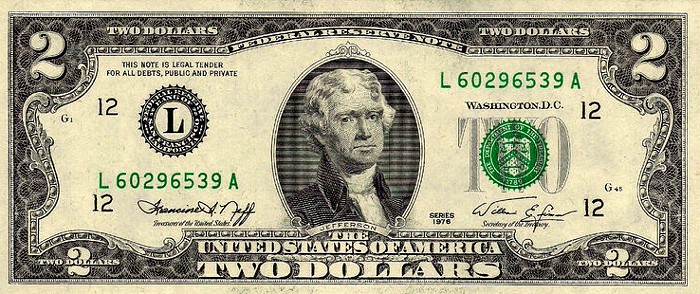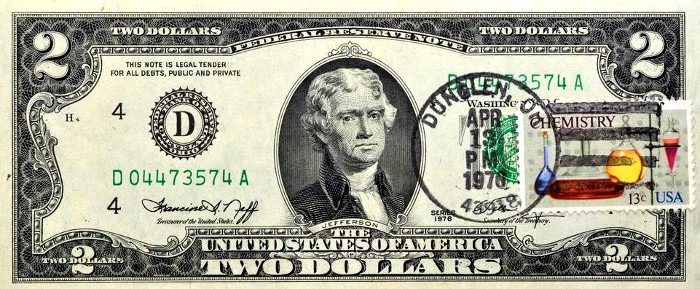The 1976 two dollar bill is a relatively old bill, but most of them aren't worth much more than their face value. However some bills can be worth more depending on a few different factors.
This was the year that the United States government re-issued the two dollar bill as a federal reserve note. Also called the Bicentennial Two, the 1976 two dollar bill was redesigned from the previous series. It has a much different look than the 1928 two dollar bill, the 1953 two dollar bill, and the 1963 two dollar bill.
Americans were interested in this bill because it had been a long time since paper currency was redesigned. Previous two dollar bill designs featured Jefferson's Monticello estate on the back of the bill. The back design now featured an image of the Declaration of Independence. In addition, the color scheme also changed. The bill now had a green seal instead of a red seal.

Specifications
| Denomination: | $2.00 U.S. Dollar |
| Type: | Federal Reserve Note |
| Seal Varieties: | One: Green |
| Series: | One |
Value
These bills aren't rare as many of them were printed- over a half billion. For this reason, most of them aren't valuable. If you have a regular circulated note then it will only be worth its face value of $2. If you have a note in uncirculated condition then it can sell for around $9-15.
It's possible to find bills with low serial numbers which are valued at a small premium. In addition, there are a few other factors that could raise the value of your bill. Below we will examine stamped bills, star notes, and a notable error bill.
Click here to search for 1976 2 dollar bills on Amazon.
Stamped Bills

The 1976 series was first issued out to the public on April 13th, 1976. People who received first day issues went to their local post office so they can get their bills stamped with the date. The value is slightly higher for stamped bills and stamps with unique city names.
Star Notes
Star notes are replacement notes that have a star before the serial number. There are both common star notes and rare star notes. What separates them is the federal reserve bank from which they were printed from. These bills were printed from 12 different federal reserve banks and two of them are rare. The Federal Reserve Bank of Kansas City and the Federal Reserve Bank of Minneapolis are the rare varieties that you should be looking for. You can check your own bill by looking on the front left hand side to see the issuing bank's name.
The common variety 1976 $2 star notes are worth around $8 in fine condition. In uncirculated condition the price is around $17.50-22.50 for bills with an MS 63 grade. The rare variety star notes can sell for around $80 in fine condition and around $150 in uncirculated condition with a grade of MS 63.
1976 Two Dollar Error Bill
There is one notable error for this series, but it's not immediatly noticeable. On each individual paper currency there is a serial number which is shown in two places on the front: the top right and the bottom left. Normally the serial number is the same in both places, but on the error bill the serial numbers are different. In most cases one of the prefixes will be different on the error bill. This was a printing error.
This two dollar error note is worth around $400 in very fine condition. In uncirculated condition the value is around $800.
Grading System
Fine- A note that shows clear evidence of having been in circulation. The note has lost its crispness and its very fine detail. The note has creases but there are no stains.
Very fine- A note that has been in circulation but not for a long time. The note is still relatively crisp. There may be some creases, folds, or light smudges.
MS 63 choice uncirculated- A note that shows no signs of ever having been in circulation. The note still has its original crispness. The note is also well-centered.
Conclusion
Most people realize that the 1976 two dollar bill isn't quite old enough to become a valuable item. But what most people don't realize is that this bill can be valuable if it has a unique stamp, if it's a rare star note variety or if it's an error bill. Valuable bills should be placed inside protective currency holders.
Sources:
